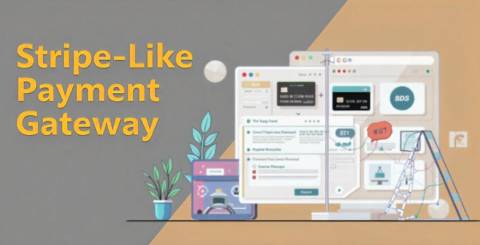How to Develop a Stripe-Like Payment Gateway in 2025 — Features, Cost & Timeline

Stripe has set the gold standard for online payments. But in 2025, businesses that process large volumes of transactions, seek full control over their infrastructure, or want to reduce dependency on third-party platforms are seriously considering building their Stripe-like payment gateways.
If you're in that boat, this guide breaks down everything you need: the key features to include, realistic development timelines, expected costs, and how modern payment gateway development services can help you launch a secure, compliant, and scalable solution.
Let’s get into it.
Why Build a Stripe-Like Payment Gateway?
Stripe is fast, flexible, and trusted. So why build your own?
Here are a few compelling reasons:
High transaction fees: With every sale, a portion goes to Stripe. For businesses processing millions, this adds up fast.
Limited customization: Stripe doesn’t always fit unique workflows or regional banking needs.
Vendor dependency: Outages, policy changes, or delayed feature rollouts can affect your business.
Data ownership: Full control of payment data enables deeper analytics and integrations.
Global compliance flexibility: Especially relevant if operating across multiple countries.
With a custom solution, you gain complete control—provided it’s built right.
Core Features Your Payment Gateway Must Include
If you’re aiming to build a Stripe-like solution, your software must include the following foundational features:
1. Multi-Currency & Cross-Border Support
Enable international transactions and support real-time currency conversion.
2. Payment Methods Integration
Credit/debit cards, UPI, ACH, wallets, bank transfers, BNPL, crypto (optional).
3. PCI-DSS Compliance & Tokenization
Secure customer card details and stay compliant with international data standards.
4. Dynamic Dashboard & Reporting
Real-time transaction insights, dispute management, refunds, and reconciliation.
5. Developer-Friendly APIs & Webhooks
Just like Stripe, your system needs clean, well-documented APIs and sandbox environments.
6. Fraud Detection & Risk Engine
Leverage AI in payment processing to detect anomalies and flag suspicious behavior in real time.
7. White-Label Capabilities
Allow third parties (like merchants or platforms) to integrate your payment stack seamlessly under their branding.
8. Automated Onboarding & KYC
Speed up merchant activation with API-based identity verification systems.
Role of AI in Payment Gateway Development
AI in payment systems is more than just a buzzword in 2025—it’s now a critical layer in fraud prevention, personalization, and smart routing.
Here’s how AI enhances your gateway:
Fraud Detection: AI models monitor user behavior and transaction patterns to block fraud in real time.
Smart Routing: Route payments through optimal processors to increase success rates and reduce fees.
Credit Scoring: If you're offering embedded finance (e.g., buy now, pay later), AI can assess risk faster and more accurately.
Customer Support Automation: AI chatbots handle chargebacks, refunds, and status inquiries with minimal human intervention.
If you're working with a forward-looking payment gateway development services provider, AI integration should be part of your planning from the start.
Timeline to Build a Stripe-Like Payment Gateway
Building a production-grade payment system isn't a weekend job. Here’s a typical development timeline breakdown:
|
Phase |
Time Estimate |
|
Requirement Analysis & Planning |
2–3 weeks |
|
UI/UX Design |
2–4 weeks |
|
Core Architecture & Backend |
6–8 weeks |
|
API Layer + Integrations |
4–6 weeks |
|
Compliance & Security Layer |
3–4 weeks |
|
Testing & Sandbox Launch |
3–4 weeks |
|
Production Deployment |
1–2 weeks |
Total Time: 4 to 6 months, depending on complexity and team size.
Pro tip: work in sprints, with testable releases after each milestone to catch issues early.
How Much Does It Cost to Develop a Custom Payment Gateway?
The total cost of building a Stripe-like gateway varies widely depending on:
The number of integrations (banks, cards, fraud tools, etc.)
Whether you need mobile apps in addition to the web
Custom feature development like subscription billing, white-labeling, etc.
Security and compliance scope
Here’s a rough pricing estimate:
|
Build Scope |
Estimated Cost (USD) |
|
MVP (Basic Payment Engine) |
$40,000 – $80,000 |
|
Mid-Tier with APIs |
$80,000 – $150,000 |
|
Enterprise Grade Gateway |
$200,000+ |
Working with an experienced payment gateway development services company will help you trim avoidable expenses without compromising on quality or security.
Why Partner with a Development Company Like Appinventiv?
Appinventiv is one of the few global tech companies with deep experience in payment gateway development services, having delivered secure, scalable solutions for fintech startups, enterprise banks, and eCommerce platforms.
Here’s why Appinventiv stands out:
Fintech-first expertise: Projects built to comply with PCI-DSS, GDPR, and region-specific financial laws.
Scalable architectures: Cloud-native builds with microservices that grow as your business scales.
Integrated AI capabilities: For fraud detection, predictive analytics, and customer behavior tracking.
Full-cycle service: From ideation and prototyping to deployment and maintenance.
In a space as sensitive and regulation-heavy as payments, you need a tech partner that doesn’t just know code—they know compliance, risk, and finance too.
Final Thoughts
Building a Stripe-like payment gateway is ambitious—but in 2025, it’s not only possible, it’s strategic. If your business processes large volumes or wants greater control over payment operations, building your own gateway may be the best investment you make this year.
Just don’t cut corners. Prioritize compliance, invest in the right team, and make room for AI in payment capabilities from day one.
Whether you’re building from scratch or looking to upgrade an existing solution, partnering with a trusted provider like Appinventiv can ensure your payment system isn’t just functional—it’s future-ready.
Frequently Asked Questions
Q1. How long does it take to build a Stripe-like payment gateway?
Typically, 4 to 6 months depending on features, compliance scope, and development resources.
Q2. What is the cost to build a custom payment gateway?
Costs range from $40,000 to $200,000+ based on complexity, security requirements, and third-party integrations.
Q3. What are the essential features in a payment gateway like Stripe?
Core features include multi-currency support, PCI-DSS compliance, API documentation, real-time reporting, fraud detection, and automated payouts.
Q4. How can AI improve payment gateway functionality?
AI helps with fraud prevention, smart routing of transactions, user behavior analytics, and faster KYC verification.
Q5. Why should I choose a company like Appinventiv for payment gateway development?
Appinventiv brings fintech expertise, proven frameworks, end-to-end service delivery, and compliance-first development—all essential for secure, scalable payment platforms.
Similar Articles
As more companies monitor productivity remotely, the risk of violating digital privacy laws grows
Keeping pets safe is a top priority for dog owners. With advancements in technology, taking care of man's best friend has become more manageable and sophisticated. Among such developments, the incorporation of GPS tracking systems has revolutionised how owners look after their dogs.
What happens when standard cameras fail in the face of extreme radiation?
Over time, truck or auto fleet tracking has grown in popularity and value. A fleet tracking device is an updated, computerized gadget that gathers data from the whole fleet to provide a complete picture of where each truck is. It not only records the truck's position but also its fuel usage, mileage, and driving history, among other things.
A vehicle tracking system provides several advantages to your business, including increased driver and vehicle safety, decreased costs, and improved productivity.
Parents worry about their children while they're away from home. It doesn't matter where your children are or what they are doing. Parents can monitor their children remotely using child tracker devices
Which is better Navionics or CMap? CMap or Navionics, which system will you choose for your fishing boat? This is one of the first questions you might ask yourself when you plan on getting a boat for personal use or for business purposes.
Criminal investigators (CIs) play a vital role in law implementation, criminal investigations, and criminal justice. They work hard to fix open cases, a job that frequently takes weeks or months to complete.
Traditionally at the end of the year, most information service providers and solutions summarize the year and present their vision for the country of aggression for the next year. We will publish a selection of 10 predictions from IS buyers by 2020. Below is the box is a link to all the forecasts we found during the preparation process.






